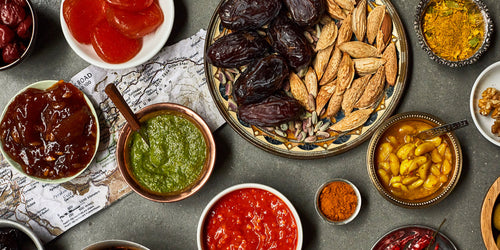Your Cart is Empty
Covid-19 has caused fundamental shifts in the ways we shop for food and cook, and with that comes silver linings. After a year spent largely at home, our collective desires have amplified in three key ways: we’re more drawn towards adventure in our kitchens, we’re prioritizing community with our spending power, and we’re seeking to heal ourselves through food.
As a result, current food trends put the spotlight on a wave of inventive and authentic products from across the globe that are keeping us inspired and connected with one another.
To help break down the 2021 landscape, we called up a few experts:
Dana Cowin, the longtime former Editor in Chief of Food & Wine whose expertise in women and POC-led food brands led her to launch Giving Broadly, a curated platform for food products.
Franklin Isacson, a partner of the venture firm Coefficient Capital, which specializes in CPG brands.
Ariel Pasternak, the founder and CEO of Pineapple Collaborative, a community-driven platform that peaks into the pantries of women tastemakers in food.

Our Kitchens Are Portals
Bolstered by international travel restrictions, the desire to explore other cultures through our own kitchens took on new precedence. And as cooking fatigue began to set in, fast-flavor solutions like Fauzia’s Jerk Seasoning and Masala Mama’s Tikka Masala Sauce have been coming in handy.
At the forefront of American consumers’ growing interest in global cuisine are regional Mexican food (specifically that of Oaxaca — think Guelaguetza’s molés), Tawainese and Sichuan products ranging from Shaoxing cooking wine to numbing peppercorns, and North African flavors like harissa and berbere.
Amongst the pantries she’s dug into over the past year, Pasternak notes “an obvious love for sauces and condiments inspired by places from around the world, whether it's [Somali] Basbaas sauce or Brooklyn Dehli’s various achaar.” Hot sauce factors into this trend, too, as Isacson says that both millennials and Gen Z are drawn towards spicier food. While the chili crisp craze is undeniable, unapologetically bold brands like Shaquanda’s hot pepper sauces (with roots in Brooklyn and Barbados) and Mama Lam’s Malaysian hot sauce (which is also made vegan), should be on your radar, too.

Meanwhile, an increase in home cooking sparked a spice boom. According to Isacson, spices sales are a “cyclical attribute” that indicate a suffering economy, since cooking is more affordable than eating out. (Spice sales were “way up” in the aftermath of the 2008 financial crisis as well.) We’re seeking to dial our dishes up a notch with rare flavors like crushed Fenugreek seeds and chaat masala from India, Acater and Oliter’s Persian lime finishing salt, and za’atar from Syria or Jordan.

Cowin thinks that blends are the future of the spice market. “If you buy mace, you have to do a lot of a particular style of cooking to use it all up,” she explains. A blend, on the other hand, can be used generously across many different applications. (We agree, which is why we’re developing a line of proprietary blends and partnerships with global spice purveyors. Keep your eyes peeled for more in the coming months.)
There’s Power in The People
Supporting and providing for our own communities is a growing and shared value amongst producers and consumers alike. As we continue to look for ways to connect with one another, including in solidarity against racial inequality and hate, the spotlight is on food products that make ethnic cuisines and cultures more accessible.
“Who are our people? What do we stand for? And how can we serve them in this terrible time, but also connect with them across multiple points?” are the questions that chefs and artisanal food producers have been asking themselves, Cowin says.

Isacson thinks that “compelling founder stories” — such as those behind Seed + Mill’s truly great halva or Skiz Fernando’s Sri Lankan curry powder— are more important than ever, with consumers wanting to buy products from makers with a connection to their communities and to their craft, as opposed to “some multinational coming out with another line of something.”
The current mood is also about forging deeper ties within our own orbits, including through food. Many of the women featured on Pineapple are industry leaders whose pantries are stocked with “their friend’s products — or maybe they’re not friends, but it’s the people they see at the farmers market or the grocery store they go to every week, and it’s personal,” Pasternak says. And in turn, when people see Jing Gao of Fly by Jing endorsing Just Date syrup or that Dana Cowin loves Maryiza single-origin forest honey from Ethiopia, there’s “camaraderie” in stocking the same products in their own kitchens. “So many people get inspiration from each other in terms of what to cook or how to nourish yourself, and it’s a really fun place of connection,” she adds.

All The Good Feels
Investing in our physical and mental health has been a necessary priority for many of us as we continue to grapple with COVID-19. According to Cowin, adaptogens and nutritional foods have become “a gigantic category” as people try to heal themselves through food.
That translates to everything from the anti-inflammatory properties of Asian red ginseng to stomach-settling Zhourat tea from Lebanon,goldenseal root for digestive aid, and antioxidant spirulina powder.
Medicinal mushrooms have also seen enormous growth. In addition to typical applications in the kitchen, shrooms are being consumed as powders in smoothies, as extracts for tonics, and more—from immune-boosting reishi to stress-combating ashwagandha.

More consumers are seeking to consume less booze, which means leveling up their bitters and syrup supply to make tasty, non-alcoholic beverages at home. And the options are plenty: Fee Brothers’ Aztec chocolate bitters, Bar Keep’s lavender bitters, Rooh-Afza’s fruit-and-herb cordial from Pakistan, Lebanese Mymouné Rose Water, and more.
And finally, the focus on healing extends beyond the benefits of specific ingredients to include intuitive cooking and feel-good food. “The act of cooking for yourself, no matter what you’re making, is a huge part of healing, especially over the course of a traumatic year,” Pasternak says. And comfort food, like pandan-flavored sweets, Hyderabadi-style biryani, or a big bowl of porcini pasta counts for that, too.




